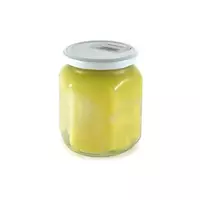Bone fat

In cooking, as well as in the food industry as a whole, various types of animal fats are actively used. In turn, animal fats mean a type of natural fat-containing compounds that are obtained from the fat or bone tissue of various species of vertebrate animals. In addition, animal fat is obtained from fish, birds, as well as reptiles.
By bone fat is meant a type of animal fat, which is a mixture of various animal fats. Bone fat is extracted from spongy as well as tubular bones of domestic animal species. Typically, tissues from cattle as well as pigs are used to produce bone fats. The distinctive taste and consumer properties of bone fats depend primarily on the variety of product.
It is worth noting that bone fats are classified depending on the quality characteristics of the product. Bone fat of the highest or first, second and third grade is isolated. In its appearance, as well as its distinctive consumer properties, bone fat of the first grade resembles butter melted butter. The color of bone fat also depends on the variety of the product.
For example, bone fat of the first grade is usually kept silent by its light or saturated yellow color. When straightened, top-grade bone fat becomes transparent. The second or third grade of bone fat is characterized by a darker greenish-gray color scheme. It is worth noting that the consistency of bone fat also depends on the variety of the product.
Bone fat of lower varieties can be in a liquid or ointment-like state. For culinary purposes, bone fat of the first grade is used. Bone fat of other varieties can be used for the manufacture of lubricants and other technical compounds. To taste, edible bone fat resembles a pork toast, and the aroma of the product can be compared to the characteristics of a rich broth.
The distinctive nutritional and beneficial properties of bone fats are primarily due to the vitamin-mineral composition of the product, which contains a significant amount of oleic acid, as well as vitamin A and beta-carotene. In addition, bone fat contains a large number of biologically active phospholipids, as well as sterols.
Food bone fat or first grade product is obtained from fresh bones of cattle or pigs, which are well purified from meat. Second and third grade bone fat is obtained from pre-ground bone residues. Edible bone fat is subjected to a refining process, i. e. double purification. Most often, bone fat in a mixture with other types of animal fats is used in baking, as well as in the manufacture of various types of culinary products.
bone fat 897 kCal
Energy value of bone fat (Ratio of proteins, fats, carbohydrates - ju):
Proteins: 0 g (~ 0 kCal)
Fats: 99.7 g (~ 897 kCal)
Carbohydrates: 0 g (~ 0 kCal)
Energy ratio (b | y): 0% | 100% | 0%
 Español
Español Français
Français Português
Português Русский
Русский 简体中文
简体中文 繁體中文
繁體中文 日本語
日本語 한국어
한국어 العربية
العربية Türkçe
Türkçe Қазақ
Қазақ Deutsch
Deutsch Italiano
Italiano Українська
Українська
